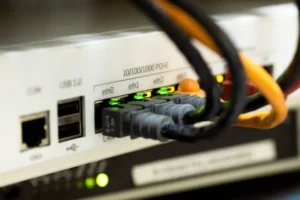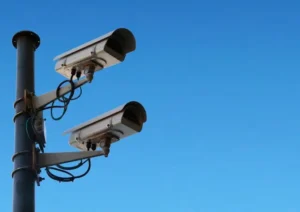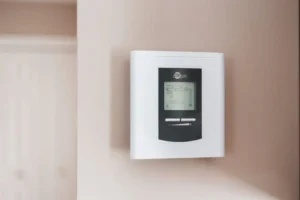Now Reading: Best Home Wi-Fi Booster: Extender, Repeater or Amplifier?
- 01
Best Home Wi-Fi Booster: Extender, Repeater or Amplifier?
- Home
- Home Internet
- Best Home Wi-Fi Booster: Extender, Repeater or Amplifier?
Best Home Wi-Fi Booster: Extender, Repeater or Amplifier?
![]() Anne MaddisonHome InternetAugust 8, 202570 Views
Anne MaddisonHome InternetAugust 8, 202570 Views

Have you ever been frustrated because your Wi-Fi signal disappears the moment you walk into your bedroom or basement? Maybe your videos buffer, your games lag, or your work calls drop when you’re just a little too far from the router. You’re not alone. Many homes have Wi-Fi dead zones, and that’s where Wi-Fi boosters come in.
Wi-Fi boosters are devices that help spread your Wi-Fi signal further across your home. But here’s where it gets confusing. You’ll see different names like Wi-Fi extenders, repeaters, and amplifiers. They all promise better internet, but they work in different ways. So how do you know which one to choose?
In this guide, we’ll walk you through the most common types of Wi-Fi boosters and explain how each one works. We’ll also talk about when you might need one, how to choose the right type, and how to get the best performance once it’s set up.
By the end, you’ll understand exactly what a Wi-Fi booster does and which one makes the most sense for your home. Whether you’re working from home, gaming, streaming, or just browsing the web, the right Wi-Fi booster can make a big difference.
What Is a Wi-Fi Booster?
A Wi-Fi booster is a device that helps make your home Wi-Fi signal stronger or reach farther. It does not replace your router or your internet plan. Instead, it works with your current setup to fill in the weak spots in your home where the signal is poor.
Most routers have a limited range. This means the farther you are from the router, the weaker your Wi-Fi signal becomes. You might notice that your internet is fast in the living room but slows down in the bedroom or upstairs. A Wi-Fi booster helps fix that by bringing the signal closer to those hard-to-reach areas.
The term “Wi-Fi booster” is used as a general name. It can refer to a few different types of devices that do similar things. The most common ones are Wi-Fi extenders, Wi-Fi repeaters, and Wi-Fi amplifiers. Each one works a little differently, and knowing how they work can help you pick the right one.
In the next sections, we will look at each type of Wi-Fi booster, what they do, and when you should use them. Understanding the difference is the key to making your home internet faster and more reliable.
Why You Might Need a Wi-Fi Booster
There are a few common signs that your home Wi-Fi needs help. One of the biggest issues is having dead zones, which are areas in your house where the Wi-Fi signal barely reaches or doesn’t show up at all. This often happens in rooms far from your router, like upstairs bedrooms, basements, or garages.
Another problem is when your devices lose connection or struggle to stay connected the farther you move from your router. This can be really frustrating if you’re trying to watch a movie, join a video call, or play a game online.
Lag and buffering are also clear signs of a weak signal. If your video keeps freezing or your call drops in the middle of a conversation, it could mean your Wi-Fi just isn’t strong enough throughout the house.
This is even more noticeable in larger homes or in households where many people are using the internet at the same time. When everyone is streaming, downloading, or gaming, the Wi-Fi has to work harder, and some areas may be left with slower speeds or no connection at all.
Before getting a Wi-Fi booster, it’s a good idea to test your current signal. You can use a free speed test app on your phone to check how strong your Wi-Fi is in different parts of your home. This will help you figure out exactly where the weak spots are and whether a booster could solve the problem.
Wi-Fi Extender: What It Does and When to Use It
A Wi-Fi extender is a device that helps your router reach areas where the signal is weak or missing. It works by grabbing the signal from your router and then sending it out again to expand your coverage. Think of it like a helper that catches your Wi-Fi signal and pushes it farther into areas that your router cannot fully reach on its own.
This is helpful in rooms where your Wi-Fi barely works or does not connect at all. If you have one or two areas in your home with slow or no signal, such as a back bedroom, basement, or upstairs office, a Wi-Fi extender can help fill in those gaps.
Wi-Fi extenders are a good choice if your internet is mostly strong, but you have a few weak spots. They are often affordable and easy to set up. Many of them plug directly into a wall outlet and can be ready to use in just a few minutes.
There are a few things to keep in mind. An extender has to be placed in the right spot to work well. If it is too far from your router, it will not get a strong enough signal to rebroadcast. If it is too close to the router, it will not help much with extending your range.
Also, using an extender can sometimes reduce your internet speed slightly, especially if it is an older model. And if it is not set up correctly, it might create a second network name. This means you may have to switch between networks depending on where you are in your house. Some people find this annoying, but it can be avoided if you choose an extender that keeps the same network name, also called SSID.
| Pros of a Wi-Fi Extender | |
|---|---|
| Easy to set up | Most extenders plug into a wall and take just a few steps to install. Many come with a mobile app or a WPS button to make setup quick and simple. |
| Cost-effective | Extenders are usually cheaper than mesh systems or extra routers. They are a good option if you want better coverage without spending a lot of money. |
| Can keep the same network name | Some extenders let you use the same Wi-Fi name as your main router. This helps your device stay connected without needing to switch networks. |
| Cons of a Wi-Fi Extender | |
|---|---|
| Needs to be placed in the right spot | If it’s too far from the router, the extender won’t get a good signal. If it’s too close, it won’t expand your coverage much. You need to find the best location for it to work well. |
| May reduce internet speed slightly | Extenders often use the same band to receive and send signals. This can lower speeds, especially when you’re doing things like streaming videos or online gaming. |
| Might create a second network name if not set up properly | Some extenders add “_EXT” or another name to your Wi-Fi. This means you may need to manually switch networks as you move around your home, which can be annoying. |
Wi-Fi Repeater: How It Works and When to Choose It
A Wi-Fi repeater is very similar to a Wi-Fi extender. It helps boost your Wi-Fi by picking up the signal from your router and sending it out again. The main difference is that a repeater connects wirelessly, without using any cables. It takes in the signal from your router and rebroadcasts it to nearby areas.
This makes it a good choice for fixing signal drops in nearby rooms or hallways. If you have a spot in your home where the Wi-Fi keeps cutting out or feels weak, but it is still close to the router, a repeater can help improve the signal without needing wires or a complicated setup.
Many Wi-Fi repeaters are plug-and-play, which means you can simply plug them into a power outlet and connect them in a few steps. They are great for people who want a quick and simple way to boost Wi-Fi without installing anything extra.
But there are a few downsides. A repeater needs to be placed where it still gets a strong signal from the router. If the signal is already weak where you plug it in, the repeater will not work well. Also, repeaters often cut your internet speed in half because they use the same channel to send and receive data. This can slow things down if you are streaming, gaming, or using a lot of devices.
Signal strength can also go down if your home has thick walls, floors, or large objects between the repeater and the router.
| Pros of a Wi-Fi Repeater | |
|---|---|
| No wires needed | Wi-Fi repeaters connect wirelessly to your router, so you don’t need any extra cables. This makes installation easier and keeps your space tidy. |
| Simple plug-and-play setup | Most repeaters are easy to install. You just plug them into a power outlet and follow a few setup steps. Many have apps or a quick WPS button to make the process fast. |
| Easy way to fix signal drops | If your internet drops in certain rooms, a repeater can help fill those dead zones. It grabs the Wi-Fi signal and sends it farther into your home. |
| Cons of a Wi-Fi Repeater | |
|---|---|
| May reduce internet speed by up to 50 percent | Because repeaters receive and send data on the same channel, this can slow down your internet speed, especially during heavy use. |
| Needs to be placed where the router signal is still strong | If the repeater is placed too far from the router, it won’t get a good signal to repeat. It works best when it can still catch a strong connection. |
| Signal may weaken if blocked by walls or floors | Physical barriers like thick walls or multiple floors can weaken the signal. This means the repeater might not work well in large or multi-story homes unless carefully placed. |
Wi-Fi Amplifier: What It Is and Who Needs It
A Wi-Fi amplifier is designed to boost the strength of the signal coming from your router. Unlike a repeater or extender that tries to expand coverage, an amplifier focuses on making the existing signal stronger and more stable. It improves the quality and power of the connection, especially near the source.
Wi-Fi amplifiers are usually found in high-end routers or part of a mesh Wi-Fi system. They are often used in homes where the router is strong but needs a performance boost, like in large spaces or houses with many connected devices.
This type of device is especially helpful for people who use their Wi-Fi for streaming, gaming, or running smart home setups. It can make a big difference in places where the signal drops for no clear reason, even though the router is nearby.
However, Wi-Fi amplifiers are not always the answer to range problems. If your issue is that the signal does not reach certain parts of your home, an amplifier may not help. They also tend to cost more and might need equipment that is compatible, like certain mesh routers or advanced settings.
| Pros of a Wi-Fi Amplifier | |
|---|---|
| Strengthens the signal at the source | A Wi-Fi amplifier boosts the signal strength directly from your router. This can improve overall performance before the signal spreads through your home. |
| Reduces signal drop or interference | It helps maintain a stable connection by making the signal stronger and more resistant to common issues like interference from walls or electronics. |
| Great for streaming, gaming, or smart homes | A stronger signal means smoother video, faster response in games, and better reliability for smart devices that depend on steady internet. |
| Cons of a Wi-Fi Amplifier | |
|---|---|
| Can be more expensive than basic extenders | Wi-Fi amplifiers often cost more than simple repeaters or extenders, especially if they include advanced features or are part of a mesh system. |
| May require compatible routers or systems | Some amplifiers only work well with certain routers or brands. You may need to check if your current equipment is supported. |
| Not useful if the issue is range, not signal strength | Amplifiers improve strength, not reach. If your problem is weak signal in far rooms, a repeater or mesh system may be more effective. |
Ultimate Comparison Between Wi-Fi Boosters
Feature | Extender | Repeater | Amplifier |
Function | Expands range | Repeats signal | Strengthens signal |
Setup | Easy | Very easy | Varies |
Signal Strength | Same or lower | Usually lower | Stronger |
Use Case | Dead zones | Short-range fixes | Boost main signal |
Price Range | $$ | $ | $$$ |
How to Choose the Right Wi-Fi Booster for Your Home
Start by asking these questions:
- Do you have dead zones or weak signal areas?
- Is your router already strong but limited in coverage?
- Do you need the same signal quality in every room?
Now based on your answers, here is what to consider:
Choose an Extender if:
- You have weak spots far from the router
- You need a simple setup and affordable coverage
Choose a Repeater if:
- You have signal issues in nearby rooms
- You want a quick and budget-friendly solution
Choose an Amplifier if:
- You already have strong Wi-Fi but want better signal power
- You need consistent speed in all parts of the house
Placement Tips for Wi-Fi Boosters
To get the best performance from your Wi-Fi booster, it’s important to place it in the right spot. Ideally, the booster should be positioned halfway between your main router and the area where the Wi-Fi signal is weak or nonexistent. This helps the booster pick up a strong signal and push it further into the dead zone. If you place the booster too far from the router, it won’t have a strong signal to work with, and the performance will suffer.
Avoid placing the booster near thick walls, large metal appliances, or heavy furniture that can block or weaken the signal. Common sources of interference like microwaves, cordless phones, baby monitors, and even Bluetooth devices can disrupt the Wi-Fi signal, so keep the booster away from these when possible.
You can also use a Wi-Fi analyzer app or tool to test signal strength in different areas of your home. These tools show you where the signal drops or becomes unstable, helping you decide where to place the booster for the best coverage. Take the time to test and adjust the placement if needed. Even a small change in position can make a noticeable difference in how well your Wi-Fi booster works.
Other Options: What If a Booster Isn’t Enough?
If a Wi-Fi booster doesn’t fully solve your connection problems, there are other solutions you can try. One option is to upgrade your router. Older routers may not support the latest Wi-Fi standards or may lack the power to cover a larger home. A newer, more powerful router can often provide better range, speed, and stability.
You could also consider switching to a mesh Wi-Fi system. Unlike a single router and booster, a mesh system uses multiple access points placed around your home to create a seamless, strong signal everywhere. This is especially helpful in larger homes or places with thick walls and multiple floors.
Another option is using Ethernet cables for devices that stay in one place, like smart TVs or desktop computers. A wired connection is usually faster and more stable than Wi-Fi.
It’s also worth checking whether your internet plan can handle your household’s usage. If you stream a lot of videos, play games online, or use smart devices, your current plan might not be fast enough. Our guide on how much home internet data you really need can help you decide if it’s time to upgrade.
Also, regular maintenance helps. Learn why rebooting your router can improve performance and how to spot signs your home router might be hacked to keep your connection safe and strong.
Final Thoughts
There are three main types of Wi-Fi boosters you can choose from: extenders, repeaters, and amplifiers. Each one has a specific purpose. Extenders are great for covering dead zones farther away from your router. Repeaters are better for fixing signal drops in nearby rooms. Amplifiers work best when your Wi-Fi signal is strong at the source but needs more power to stay consistent across your home.
Choosing the right type depends on your home layout, your internet usage, and where your signal problems happen. Take some time to think about what your home needs. Are there areas where your Wi-Fi disappears completely? Do you have a strong signal that just doesn’t reach far enough? Or do you need a stronger signal to handle gaming, video calls, or streaming on multiple devices?
Before you buy anything, try using a free speed test app to check how strong your Wi-Fi is in different parts of your house. This will help you map out weak zones and figure out which type of booster will work best for you. With the right setup, you can enjoy stronger, faster, and more reliable internet throughout your home.
Previous Post
Next Post
Previous Post
Next Post
Home AppliancesJuly 27, 2025
What Air Conditioner Size Do I Need?
Home AppliancesJuly 28, 2025
Can Air Conditioner Make You Sick?
Climate ControlAugust 24, 2025
Are Home Air Conditioner Tune Ups Necessary
Climate ControlAugust 23, 2025
Can Air Conditioning at Home Trigger Asthma?
- 03
Home AppliancesJuly 27, 2025
What Air Conditioner Size Do I Need?
- 04
Home AppliancesJuly 28, 2025
Can Air Conditioner Make You Sick?




















